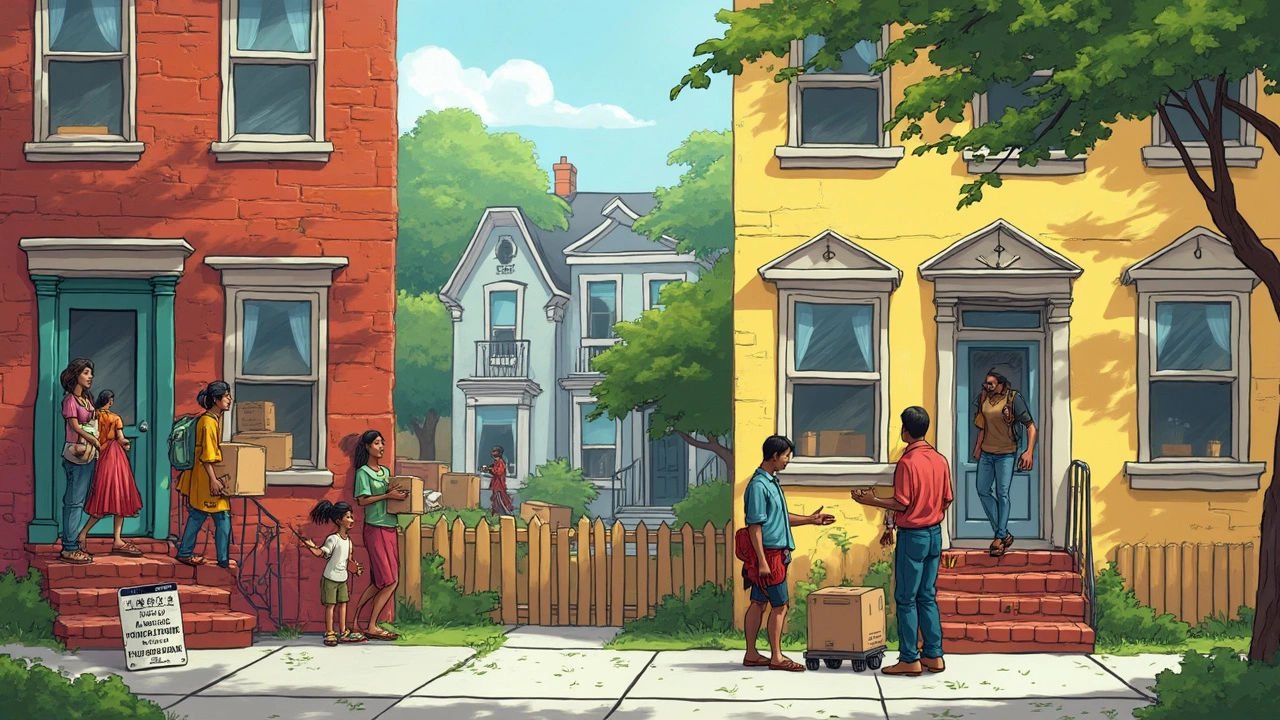How Many Tenants Can Live in a House in Virginia? Rules Every Renter Needs to Know

May, 18 2025
Ever wondered if you can squeeze a few more roommates into your Virginia rental without breaking the law? You’re not alone. The rules are surprisingly clear, but a lot of folks misunderstand what's actually allowed. In Virginia, it all comes down to how many people you have per bedroom, local city rules, and what’s written in your lease.
Most of the time, the state follows something called the "two-plus-one" rule: that’s two people per bedroom, plus one extra in the house. So, a three-bedroom place could fit up to seven people legally. But don't get too comfy yet—some cities and counties have tighter restrictions or define "family" in a certain way, which can trip you up if you aren’t careful.
- Virginia's Legal Limits for Tenants
- Bedroom Count and the Two-Plus-One Rule
- City and County Tweaks: Why Location Matters
- Landlord Perspectives and the Lease Agreement
- What Happens if You Break the Rules?
Virginia's Legal Limits for Tenants
Virginia spells out who can live where pretty plainly, but too many people just guess. Here’s how it really works—straight from the Virginia Uniform Statewide Building Code, which is basically the state’s playbook for Virginia tenant limits. The general rule says you can have two people per bedroom, plus one more person anywhere in the house. So if you rent a two-bedroom? That’s five people max, unless they’re all related by blood, marriage, or adoption.
Now, Virginia law doesn’t usually count kids under two when figuring out who counts toward that limit. Got a baby in a crib? Most cities won’t make you count them as part of your official headcount. This is huge for young families crammed into a small apartment.
Don’t forget, unrelated adults are what most landlords and local rules care about. If cousins, step-brothers, or old friends want in, they might hit problems with the headcount even if you’re all on good terms under one roof.
One more thing: the law sometimes gives exceptions for disabilities or certain family situations. There are federal Fair Housing rules about this, but in most cases, Virginia’s two-plus-one rule is the starting line. Always check your local ordinances, too, since a rural county might be chill but a college town could get strict because of party houses.
Bedroom Count and the Two-Plus-One Rule
This is where things get practical. In Virginia, state law uses the "two-plus-one" rule to figure out how many tenants can legally stay in a rental. Here’s what that means: for every legal bedroom in the house, you can have two people—and you can add one extra, regardless of bedroom count. That one extra person is basically a free pass across the whole house.
Let’s say you’re eyeing a three-bedroom rental. With this rule, you could fit up to seven people. That’s way more than folks expect, and it makes sharing rent easier. But, there’s a catch: the room has to count as a legal bedroom. No, you can’t just stick a futon in the storage room and call it a day.
- A legal bedroom needs an exit window, a closet (in most places), and must be at least 70 square feet.
- For kids under 2, they often don’t count toward the total. So babies in cribs can sometimes be extra, as long as the lease allows.
Check out this table for a quick look at how the two-plus-one rule works in practice:
| Bedrooms | Max Tenants (Two-Plus-One Rule) |
|---|---|
| 1 | 3 |
| 2 | 5 |
| 3 | 7 |
| 4 | 9 |
This "two-plus-one" rule lines up with federal HUD guidelines too, so it’s not just a local thing. And to be clear, this is the default rule—if your lease says something stricter, your landlord can make you follow that. But if the landlord tries to go even tighter than the laws allow, you might have a case to push back.
Occupancy limits like these matter for safety, insurance, and making sure the Virginia tenant limits aren’t stomped all over. If you’re not sure about your place’s bedroom status or you think your group is right at the edge, check the local building code. Also, don’t forget most leases require everyone to be listed by name, so don’t try sneaking in extra people hoping nobody notices.

City and County Tweaks: Why Location Matters
Now here’s where things can get tricky—your exact address really changes the game. Virginia has some basic rules, but counties and cities can add extra layers. For example, Fairfax County is a hot spot for tight rules. They say no more than four unrelated adults can live in a single-family home, even if there are plenty of bedrooms. That means a five-bedroom house doesn’t get you a pass if you’re all just buddies sharing rent.
Look at Arlington County—they dropped the unrelated occupant limit back in 2019, so there’s a little more wiggle room for roommates. But don’t assume every place plays nice. Certain college towns like Charlottesville use stricter “zoning overlays” to prevent big groups from piling into houses in quiet neighborhoods. Some spots in Richmond only allow up to three unrelated tenants. It can literally change from block to block if you’re close to a university.
A local government guide from Fairfax puts it simply:
“You must follow the most restrictive occupancy code—city, county, or state—at your specific property.”
This means if your county sets a lower maximum than the state’s two-plus-one standard, the stricter rule wins. And if your landlord puts a different cap in the lease, it sticks as long as it’s at or below local law.
- Always check local codes online—or just call the city zoning office and ask for the exact occupancy limit at your address.
- If your house is in a neighborhood with an HOA, keep an eye out for even more restrictions buried in their rules.
- If you find a cheap rental with an unusually high headcount, double-check it’s legit before moving in. Fines for breaking occupancy rules are no joke, especially in northern Virginia counties.
Bottom line: when it comes to Virginia tenant limits, your zip code makes all the difference. You’ve got to get this right to avoid headaches, fines, or worse—getting kicked out with zero notice.
Landlord Perspectives and the Lease Agreement
Landlords in Virginia care a lot about how many folks are living in the property, and it’s not just about feeling nosy. There are practical reasons for this. If you let too many people move in, that’s extra wear and tear, higher water and utility usage, and a bigger risk when it comes to noise or even damage. Most landlords spell out the occupancy limit right in the lease, so if you’re planning to bring in a cousin, a best friend, or some distant relative, you need to double-check what you already signed.
Here’s the thing: even if state law says seven people could fit in a three-bedroom place, your lease might say no more than five. Your landlord calls the shots as long as they don’t discriminate against protected groups (that means race, religion, family status, and so on). The Fair Housing Act is the big federal law here, but Virginia has its own rules too—both say your landlord can’t set different limits just because you’ve got kids, for example. But if your landlord sets the same limit for everyone, that's fair game.
Some leases are super specific: they’ll list every tenant by name, and make it clear you can’t have anyone move in without written permission. Others just set a max number. Always read yours before you agree, because ignoring that part can get you an eviction notice, no matter what other laws say.
Check out this quick table for what landlords in Virginia usually include in rental agreements:
| Lease Feature | Typical Details |
|---|---|
| Occupancy Limit | Usually 2 per bedroom, sometimes less |
| Named Tenants | Each adult must be listed by name |
| Guests/Visitors | Stays over 14 days in 6 months often require approval |
| Violation Consequence | Warning, then potential eviction |
If the rules in your lease conflict with the local law, the stricter rule usually wins. So even if county code is flexible, your lease may have the final say. If in doubt, talk to your landlord before making changes. Transparency usually keeps everyone out of trouble and helps avoid nasty surprises down the road.
One tip: keep every communication in writing. Texts and emails help if you ever need to prove what was (or wasn’t) agreed. Renting in Virginia’s all about understanding the Virginia tenant limits and backing that up with what’s written down. That’s how you avoid headaches—trust me, it’s worth the five-minute read-through.

What Happens if You Break the Rules?
If you go over the legal tenant limit in Virginia, there are some pretty real risks. First up, landlords almost always consider this a clear lease violation. That means they can give you a written notice to fix the problem—usually called a "notice to cure." If you don’t move out the extra folks or solve it in time (often within 21 days), your landlord can start eviction proceedings through the court. Doesn’t matter if it’s your cousin, best buddy, or even someone quietly crashing in the basement—the rule applies the same way.
Local zoning codes can get involved too. If a neighbor complains, the city or county might send out an inspector. In cities like Arlington or Fairfax, this is legit common. If they find you’ve gone past the limit, you can get fined—sometimes hundreds of dollars per day until things are fixed. Some areas will even charge the Virginia tenant limits per extra head in the house, so it adds up fast.
And here’s the kicker: renters insurance and even fire protection systems like smoke alarms are usually rated for a certain number of people. Stuffing ten folks into a three-bedroom isn’t just against the rules—it can be dangerous in an emergency. Plus, insurance might deny claims if they find out you filled the place over capacity.
Think you can just hide it? Landlords sometimes check for surprise guests by doing routine inspections (with proper notice, of course). If they see signs of more people—extra mattresses, tons of toothbrushes, packed parking—it’s easy for them to take action.
If you’re on the fence, talk to your landlord before someone new moves in. It’s a headache now, but nothing compared to court dates, eviction fees, and scrambling last minute to find a new place. When in doubt, stick to the listed max on your lease and triple-check any local rules for your city or county.